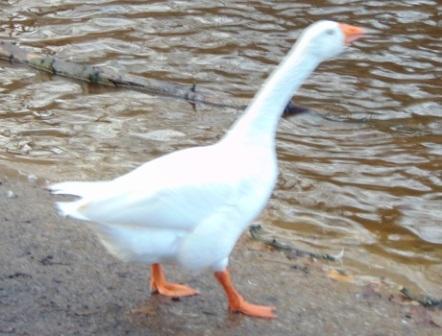Geese are large water birds with a medium neck, situated between duck and swan. They live in groups (gaggle on the ground, skein, team or wedge when flying (plump if close together)) (family Anatidae, subfamily Anserinae (swans and geese). In Europe, two types exist. Anser (Grey Goose) and Branta (Black and white geese).
They love to swim and bathe, but specialize in grazing and live more in the country. Therefore they have strong, fairly long legs, and they walk well.
Geese graze. They also eat roots and plants. In the winter they seek corn, potatoes, turnips, carrots in fields and stubble. After dinner, they fly to a lake to go to sleep.
 Geese can be up to 30 years old, they are only fertile from their 3rd year of life. Male and female look the same externally. The female is smaller and has a larger potbelly (down under the goose) than the gander.
Geese can be up to 30 years old, they are only fertile from their 3rd year of life. Male and female look the same externally. The female is smaller and has a larger potbelly (down under the goose) than the gander.
Geese are monogamous couples throughout their lives together. If one dies, the other remains mostly alone.
Wild geese are migratory birds. They breed in the far north (Scandinavia and Siberia). In the fall, when the harsh arctic winter begins, they fly thousands of miles to the south, often to the Mediterranean.
Sometimes they come just to eat and rest. One million geese remain overwinter here. In February, March and April, they fly back.
They often fly in V-formation. Who first flies must work the hardest, so they switch off to save energy. The geese that follows uses the lift force that follows from the wings of the predecessor.
When a goose gets sick or is wounded two geese will remain with the patient until it is healed or deceased. Together, the geese will try to catch up their group again.
We see in our region white-fronted geese, bean geese, pink-footed geese, brent geese, barnacle geese and tundra bean geese.
Greylag geese, Canada geese and nile goose are breeders here.
Greylag geese prefer breeding in swamps and lakes. The female makes of twigs, grass, leaves, and down a nest on the ground. The goose lays three to eight eggs. She incubates and the gander stands guard. After four weeks, the goslings hatch. After a few days they leave the nest to find food. The mother cares two months for her kids.
Geese lose their flight feathers all at once. They cannot fly a couple of weeks.
Moult usually coincides with the period when the goslings are in the nest.
In a gaggle always a few geese are on the lookout. The others can then graze quietly. When in danger, the guards alert with their honk. The Romans used them already as alarm.
Foxes, hedgehogs, feral cats, magpies, crows and jays are fond of eggs and chicks. Rats rob even sometimes eggs under a broody goose away!
Formerly was written with goose feathers, which were dipped in an inkwell.
Also to stabilize arrows feather pens were used. And down is for comforters.
To lure, trap and hunt, see ducks (identical).
There are all kinds of decoy calls.
Why migratory birds fly south? Because walking is too far.
Just shot my first goose. Everyone stood shivering in the frozen food section.
